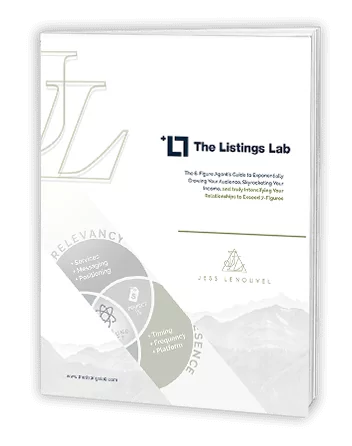Does this sound familiar?
“I’m not on track to complete any of the big goals I planned for this year.”
How about this?
“I’m not sure what I need to focus on or what I need to be working on.”
Many real estate agents feel this way at some point as they scale their businesses.
But there’s one tool you can use to overcome the uncertainty:
Intentional goal setting.
Start by envisioning your long-term goals.
Paint a clear picture of where you ultimately want to be in ten years.
Then, the real magic happens when you break your 10-year goal down into smaller, more manageable goals – 3-year, 1-year, and quarterly increments.
This way, you have clear, actionable steps that move you closer to making that 10-year vision a reality.
So, step away from uncertainty and gain clarity over your real estate goals with a definitive and effective plan for success.
Here’s how!
Setting Long-Term Goals As A Real Estate Agent
I’ve seen far too many agents who only focus on the now and neglect future goals.
Realtors get trapped in a cycle of always chasing after the next deal – instead of planning long-term.
This kind of short-term thinking can make it nearly impossible to reach your vision.
If you don’t have a map for where you want to go, how can you possibly expect to get there?
This is why you need clarity in your vision.
Ask yourself, where do you see your business 10 years from now?
By having the vision piece clear, you can set actionable goals to hit your 10-year targets.
That vision of what you want your life to look like ten years from now drives how you set your goals.
Your goals then drive all of your planning.
Once you’ve planned how you’ll reach your goals, your planning dictates your resources and how they get allocated.
Then, the resources you allocate drive your execution.
Do you need to outsource certain things? Get more training for yourself? How are you going to use your time?
Finally, your execution will always directly influence your results.
The key to all of this comes back to: Do you really know what you want?
Do you know where you want to be ten years from now?
So many agents are short-sighted in their thinking. It’s time to think beyond what you want to achieve this year.
Instead, start thinking about what you’re building towards with your long-term vision.
Is what you’re doing pushing you closer or further away from that ultimate dream?
Breaking Down Your 10-Year Vision
Once you’re clear on where you want your real estate business to be in ten years, don’t get distracted by shiny things along the way.
You need a clear path that leads you to your 10-year vision. Then, you must rigorously follow it without veering off track.
Start by breaking that 10-year vision down into three-year increments.
Identify the priorities that need to happen to reach that first three-year milestone.
Then put tasks in place to reach that goal.
These three-year milestones become your map to reach your final destination.
To gain clarity on your 3-year targets, there are a few things you want to consider:
Your Finances
By the end of your first three-year milestone, where do you want to be from a revenue standpoint?
What’s your profit?
How much do you have in savings?
Do you have passive income streams built out?
Think of your finances as a whole – not just your business, but your whole life.
How are you building your business to support the lifestyle you want?
Your Team Structure
You can’t be a solo agent forever if you want to build a 7-figure real estate business.
“Trying to” will only lead to burnout.
So, in three years, are you still a solo agent?
If not, how are you going to build a real estate team?
Additionally, part of creating your team structure comes from deciding if you thrive in a more visionary or operational role.
Think about how you want to fit into your team.
Do you prefer to be knee-deep in operations or are you a visionary who loves coming up with ideas and planning for the future?
Having a clear understanding of this will help you build a high-performing team that keeps you in your zone of genius!
Your Time Off
Finally, consider how much time you want to spend working.
Clarity in terms of money and finances is one thing.
But it’s important to remember not to get so caught up in hitting your revenue milestone that you forget to take time off.
How much do you want to be working per week?
Are you working a full 8-hour day or a 3-hour day?
How much vacation time do you have without your phone or laptop, completely off the grid?
Considering these factors – your work hours, daily schedule, and vacation time – is crucial.
They’re just as important as financial goals in creating a balanced and sustainable business.
Which brings us to this important reminder:
Your Goals Can’t Just Be Monetary
Success in real estate involves more than just financial gains.
I firmly believe that people who allow their work to bleed into their personal lives have a lower chance of being successful.
Instead, you put yourself at a higher risk of burnout.
The reality is it’s not all about the grind 24/7.
Instead, set boundaries on your work hours and use your limited time to work on the most needle-moving tasks.
Then, you’ll have more energy to actually move closer to your goals for your real estate business.
So, how does limiting your work hours factor into your 3-year plan?
Create Your Ideal Schedule
As a real estate agent, when setting your 3-year goals, think about your ideal schedule.
Map out an entire week of what your ideal day should look like in three years.
Do you want to be able to drop off and pick up your kids from school every day – and do super focused work in between?
Do you want to have someone else running the day-to-day of your operations?
Do you want to divide your weekly workload into types of tasks that you can focus on each day?
Mapping out your ideal week helps you visualize and work towards a business that lets you put your life first.
These set the foundation of your 3-year plan for your real estate business.
With them, you can craft the building blocks to make your 3-year plan a reality.
Then, you’ll have deeper clarity to gauge whether you’re on track to reach your 10-year goals.
Planning Your Annual Goals As A Realtor
Now that you have your 3-year real estate business goals planned, it’s time to plan your annual goals.
Just like your 10-year plan, your 3-year plan also gets broken down into thirds – which become your 1-year goals.
Your 1-year goals should be mainly focused on where you want your revenue, profit, and personal pay to be.
How many transactions do you need to hit those targets?
How do you plan to find the leads you need to fulfill your money goal?
Really think about what exactly you need to be focused on in the next year for you to reach your 3 and 10-year goals.
Then, identify what your annual goals should look like.
Achieve Your Goals By Setting Quarterly Rocks
The next step is to set your quarterly rocks in your 90-day plans.
The Quarterly Rocks Analogy was created by Gino Wickman to symbolize the importance of prioritizing your 90-day goals.
It works like this:
Imagine you have an empty jar, and this jar is one specific size.
Many realtors get distracted from their main goals by falling into the shiny object syndrome. When this happens, you throw sand and pebbles into your jar.
Meanwhile, the rocks are the pieces of your business that absolutely have to get done this quarter.
But if your jar is already too full of sand and pebbles, you won’t have room to squeeze your rocks in.
When you’re planning your quarterly goals, your major business priorities HAVE to come first.
Anything else not directly related to those priorities is secondary.
This keeps you focused firmly on track to achieving your vision.
How to Plan Your Quarterly Goals
The first step to planning your real estate quarterly goals is knowing what your rocks are.
What do you NEED to prioritize this quarter to reach your money goals?
Decide what your major projects are for the next 90 days, then break them down into daily tasks.
For most real estate agents, this comes down to knowing where there’s the most opportunity.
Where do you want your income to be and what does that look like in terms of transactions?
Get really specific here. Analyze your market and the average sale price of properties in your area. Find the exact number of transactions you’ll need to meet your money goal.
Now, figure out where those transactions will come from.
This can normally be broken down into referrals, new clients, repeats, and people in your audience who are already warm to hot.
Here’s how to audit your lead sources to discover where you have the most opportunity:
Auditing Your Lead Sources
Most realtors are only marketing toward the 3% of people who are ready to buy or sell their homes now.
However, by only marketing to this small percentage of leads, you’re ignoring the rest of your lead sources.
Most real estate opportunities lie in targeting people in the information-gathering stage (approximately 17% of your audience) or leads who are even earlier in the process, in the problem-aware stage (approximately 20% of your audience).
Identify where the majority of your opportunity is coming from before setting your quarterly goals.
This way, you know where to aim your focus to keep the needle moving forward.
To help you narrow this down, do a simple audit of the four main lead sources:
1. Referrals
Everyone always thinks referrals are the easiest way to generate new business.
However, it takes work to keep your referral database warm.
If you haven’t been maintaining your database, it’s going to be hard to earn transactions through referrals.
2. New Clients
New clients are the ones who found you from organic social media, paid traffic, free downloads or trainings you offer, and communities that you join.
How good are you at taking these people from completely cold to hot?
Your lead generation strategy is a huge part of how well you convert new clients.
Ask yourself: how many people are finding you on a regular basis and how many of those people do you actually convert?
Rate yourself on how well your lead generation works at bringing you new leads.
Many agents struggle with converting new clients because they aren’t bringing in enough people.
The top of their funnel is broken.
Think of it this way: If you want 20 extra deals a year from now with new clients alone, you have to bring in about a thousand new people into your audience every year.
Can your lead generation systems handle that?
3. Repeats
Look at the people you’ve worked with before.
It’s crucial that you maintain that database – especially if the market has changed.
This can be as simple as becoming Facebook friends with every single person you’ve ever worked with.
The goal is to keep them warm to you so when the time comes 3-7 years from now and they’re ready to buy or sell again, you’ll already be top of mind.
As you audit your repeat clients, take the time to also look at how well you’re maintaining these relationships in an automated way.
Rate yourself on this as well.
Even sending regular emails to keep them updated on your business and your services can have an impact on your number of repeat clients.
By keeping your clients warm and up-to-date, you foster long-term loyalty.
4. Warm to Hot Leads
Your warm-to-hot leads are the ones who are already in your audience.
They are the ones who have been following you for a while but haven’t needed your services yet.
With these leads, your goal is to advance them down the customer’s journey so that they go from curious about your services to realizing they need your services – and sending an inquiry.
Can you easily take them from where they are in your nurture system and get them to become a client?
With these four lead sources in mind, rate yourself from 1 to 10 on how good you are at converting within each source.
Out of your referrals, new clients, repeats, and warm-to-hot leads, where are you receiving the most sales? Which ones are you underleveraging?
Maybe you realize you’ve already got some inbound leads from social media, even while just posting a couple of times a week. Time to amp up your visibility there and create a 90-day content strategy!
Maybe you realize you’ve got a strong client experience and have gotten a couple of referrals, but you could be even better at maintaining your database and systemizing your follow-up. You might decide to prioritize these projects to get more referrals.
When you understand how you rank in your lead sources, you can better plan for your money goals.
Then you can set your quarterly rocks and the daily tasks that need to happen for you to make your real estate goals a reality.
As a real estate agent, it’s always tempting to put all of your focus into chasing the next deal and landing the next sale.
But when you get intentional with your long-term vision and set clear goals to follow along the way, you’ll have a clear path to creating a real estate business that works for you.
If you need help creating your long-term marketing goals, apply to join us in The Listings Lab.
Our program has helped hundreds of real estate agents create a roadmap to achieve their goals without hustling or working 60-hour weeks.
We give you the step-by-step framework to create a sustainable, profitable real estate business aligned with your ultimate life vision.
Book a FREE call with our team to see if The Listings Lab is right for you.








